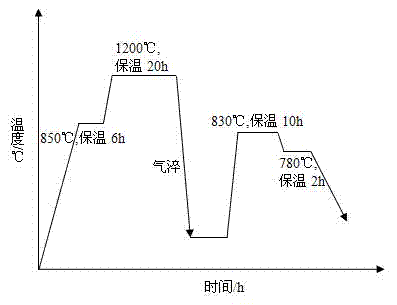Rare earth-containing Cu-Ni-Fe alloy inert anode material and heat treatment method thereof
A heat treatment method and cu-ni-fe technology are applied in the field of heat treatment of high-temperature molten salt aluminum electrolytic alloy inert anode materials to achieve the effects of reducing the impurity content of aluminum ingots, improving electrolytic performance, and improving anode corrosion resistance.
- Summary
- Abstract
- Description
- Claims
- Application Information
AI Technical Summary
Problems solved by technology
Method used
Image
Examples
Embodiment 1
[0033] An alloy material suitable for the inert anode of the metal molten salt electrolytic cell, the alloy mass composition is: 47.5% copper, 30% nickel, 15% iron, 5% aluminum, 2.5% La. The anode is subjected to double-stage homogenization and double-stage aging treatment in a high-temperature vacuum quenching furnace. The heat treatment process is:
[0034] Step 1: Slowly heat the alloy to 840°C at a heating rate of 4°C / min, and keep it warm for 6 hours, so that the low melting point rare earth phase is fully re-dissolved;
[0035] Step 2: Continue heating the alloy to 1200°C at a heating rate of 10°C / min and keep it warm for 40 hours to dissolve the coarse NiAl phase during casting and eliminate the dendrite structure in the cast state to obtain a uniform single-phase structure;
[0036] Step 3: Perform rapid gas jet quenching on the alloy at high temperature, keep the cooling rate at 5-20°C / s, and continue jetting until the alloy is cooled below 400°C to obtain the supersa...
Embodiment 2
[0041] An alloy material suitable for the inert anode of the metal molten salt electrolytic cell, the alloy mass composition is: 49.5% copper, 30% nickel, 15% iron, 5% aluminum, 0.5% La. The anode is subjected to double-stage homogenization and double-stage aging treatment in a high-temperature vacuum quenching furnace. The heat treatment process is:
[0042] Step 1: Slowly heat the alloy to 840°C at a heating rate of 4°C / min, and keep it warm for 4 hours to fully dissolve the low melting point rare earth phase;
[0043] Step 2: Continue heating the alloy to 1200°C at a heating rate of 10°C / min and keep it warm for 40 hours to melt back the coarse NiAl phase during the casting process and eliminate the as-cast dendrite structure to obtain a uniform single-phase structure;
[0044] Step 3: Perform rapid gas jet quenching on the alloy at high temperature, keep the cooling rate at 5-20°C / s, and continue jetting until the alloy is cooled below 400°C to obtain the supersaturated so...
Embodiment 3
[0049] An alloy material suitable for the inert anode of the metal molten salt electrolytic cell, the alloy composition mass percentage is: 51.5% copper, 30% nickel, 18% iron, 0.5% Y. The anode is subjected to double-stage homogenization and double-stage aging treatment in a high-temperature vacuum quenching furnace. The heat treatment process is:
[0050] Step 1: Slowly heat the alloy to 850°C at a heating rate of 4°C / min, and keep it warm for 4 hours to fully dissolve the low-melting rare earth phase;
[0051] Step 2: Continue heating the alloy to 1180°C at a heating rate of 10°C / min, and hold it for 24 hours to eliminate the Cu-rich and NiFe-rich dual-phase structure formed during the casting process to obtain a uniform single-phase structure;
[0052] Step 3: Perform rapid gas jet quenching on the alloy at high temperature, keep the cooling rate at 5-20°C / s, and continue jetting until the alloy is cooled below 400°C to obtain a single-phase supersaturated solid solution st...
PUM
 Login to View More
Login to View More Abstract
Description
Claims
Application Information
 Login to View More
Login to View More - R&D
- Intellectual Property
- Life Sciences
- Materials
- Tech Scout
- Unparalleled Data Quality
- Higher Quality Content
- 60% Fewer Hallucinations
Browse by: Latest US Patents, China's latest patents, Technical Efficacy Thesaurus, Application Domain, Technology Topic, Popular Technical Reports.
© 2025 PatSnap. All rights reserved.Legal|Privacy policy|Modern Slavery Act Transparency Statement|Sitemap|About US| Contact US: help@patsnap.com

